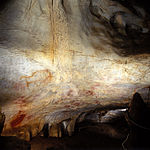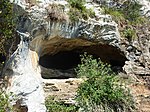Cueva de La Pasiega, or Cave of La Pasiega, situated in the Spanish municipality of Puente Viesgo, is one of the most important monuments of Paleolithic art in Cantabria. It is included in the UNESCO World Heritage List since July 2008, as part of the inscription: Cave of Altamira and Paleolithic Cave Art of Northern Spain.The cave is located in the heart of the uniprovincial community, in the middle of the Pas River valley, around the cave of Hornos de la Pena and Monte Castillo, in the same group of caves as Las Monedas, Las Chimeneas, and the cave of El Castillo. The caves of Monte Castillo form an amazingly complete series, both as regards the material culture of the Old Stone Age and from an artistic point of view. La Pasiega is basically an enormous gallery, its known extent more than 120 meters, that runs more or less parallel to the slope of the mount, opening to the surface at six different places: six small mouths, the majority obstructed, of which two can be accessed for inspection. The principal gallery is approximately 70 meters and opens to deeper secondary galleries, winding and labyrinthine, which in places broaden out to form large chambers. Thus one refers to "room II-VIII", the room called "Gallery B", or "room 11" of "Gallery C", all with paleolithic decorations.
The recorded remains belong mainly to the Upper Solutrean and the Lower Magdalenian ages, although older objects are also found. In 2018 uranium-thorium dating revealed a scalariform (ladder shaped) symbol to be older than 64,000 years and therefore made by Neanderthals. Throughout the cave are many 'walls' with paintings and with engraved or incised images. There are representations of equines (horses), cervids (deer, male and female) and bovines (cattle). There are also many abstract symbols (idiomorphs), suggesting patterns of repeated characters.









